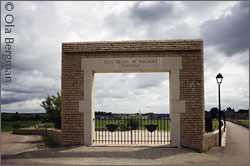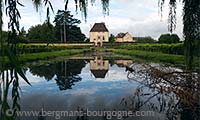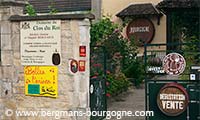
ougeot may be the smallest commune on the Côte d'Or. Still its name is well known throughout the world, mainly thanks to the Château du Clos de Vougeot, the Confrérie des Chevaliers du Tastevin and the Clos de Vougeot. The walled grand cru vineyard of the Clos de Vougeot represents more than 80 percent of the commune's land. The annual production of grand cru wine is 240 000 bottles. Together premier cru and village wine only account for 76 000 bottles a year. Most of it is red, but there is a small amount of white wine both on village and premier cru level.
The premier crus – Les Petits Vougeots, Le Clos Blanc (known as La Vigne Blanche in the past) and Les Cras – are grouped together just north of the Clos de Vougeot, just above the village. Part of Les Petits Vougeots is the Clos de la Perrière, a monopole owned by Domaine Bertagna. Also the Clos Blanc is a monopole, owned by Domaine de la Vougeraie in Premeaux-Prissey. They also have a monopole on village level in Vougeot, the Clos du Priuré which is part of the climat of Le Village.

The Clos de Vougeot itself has become the most frequently used example of how fragmented vineyard ownership can be in Burgundy. With its 80 or so owners the Clos illustrates the importance of choosing the right producer when choosing a wine in Burgundy. Every year there will be a large number of Clos de Vougeot bottles. Many of these are lovely, others less so.
The Clos de Vougeot dates back to 1098. Initially the only buildings there were farm buildings. In 1551 the chateau was added. It remained under the ownership of Cîteaux for nearly seven centuries. Then came the French Revolution and both the chateau and the vineyards were confiscated. From 1818 up to 1944 the chateau changed hands a couple of times. In 1944 the owner, a Côte-d'Or deputy, Étienne Camuzet, decided to hand it over to the Confrérie des Chevaliers du Tastevin. Five years later the chateau was classified as a national monument and opened to the general public.

The Confrérie des Chevaliers du Tastevin was founded on November 16, 1934 by Camille Rodier (1890-1963) and Georges Faiveley (1887-1968), both from Nuits-Saint-Georges, as a way to promote the Burgundian gastronomy and wines. The situation was far from uplifting. The Great Depression had hit the world, starting with the Wall Street Crash on October 29, 1929, known as Black Tuesday. Despite a handful of good vintages in Burgundy the wine did not sell, so they figured that they might as well invite some friends and taste the wines themselves. The initiative did however have the desired effect; the press caught on to it and the Confrérie – and Burgundy – got the much needed publicity. During World War II the brotherhood was temporarily put on hold, but returned as soon as more peaceful times arrived.
 It had all begun the year before when the Syndicate d'initiative de Nuits-Saint-Georges was founded. By then Camille Rodier had published two books – Le Vin de Bourgogne (1920) and Le Clos de Vougeot (1931). Coming from a négociant family – Maison Henri de Bahèzre – in Nuits-Saint-Georges he took on the responsibility for the Syndicate. One of the first ideas was to initiate a day dedicated to the Nuits wines in connection with the annual wine auction at the Hospices de Beaune. An old abandoned cellar – the Caveau Nuiton – was renovated and on January 20, 1934 the tradition of celebrating Saint-Vincent was resumed with a dinner party that among other things included 135 metres of boudin – blood sausage – and 85 metres of andouille.
It had all begun the year before when the Syndicate d'initiative de Nuits-Saint-Georges was founded. By then Camille Rodier had published two books – Le Vin de Bourgogne (1920) and Le Clos de Vougeot (1931). Coming from a négociant family – Maison Henri de Bahèzre – in Nuits-Saint-Georges he took on the responsibility for the Syndicate. One of the first ideas was to initiate a day dedicated to the Nuits wines in connection with the annual wine auction at the Hospices de Beaune. An old abandoned cellar – the Caveau Nuiton – was renovated and on January 20, 1934 the tradition of celebrating Saint-Vincent was resumed with a dinner party that among other things included 135 metres of boudin – blood sausage – and 85 metres of andouille.
Soon the chapter meeting of the Confrérie des Chevaliers du Tastevin that takes place on the on Saturday night on the third weekend of November became part of what would be called the Trois Glorieuses – a three day event celebrating Burgundy and its wines. The chapter meeting, the dinner on Saturday night is followed by the famous wine auction of the Hospices de Beaune at the Hôtel-Dieu on Sunday afternoon and the banquet Paulée de Meursault on Monday afternoon. The Paulée de Meursault, with over 700 guests attending, was brought back to life by Count Jules Lafon in 1923. Before the French Revolution the monks at Cîteaux had organized an event like this every year as way of thanking the harvesters. One of the founding members of the Confrérie, Georges Rozet from the Mâconnais, came up with the name the Trois Glorieuses.
The brotherhood is also responsible for the Saint-Vincent Tournante that is arranged every January in honour of the patron saint of the wine growers, Saint-Vincent. As the name suggests this is an event that moves to a new village every year.
© 2013 Ola Bergman













